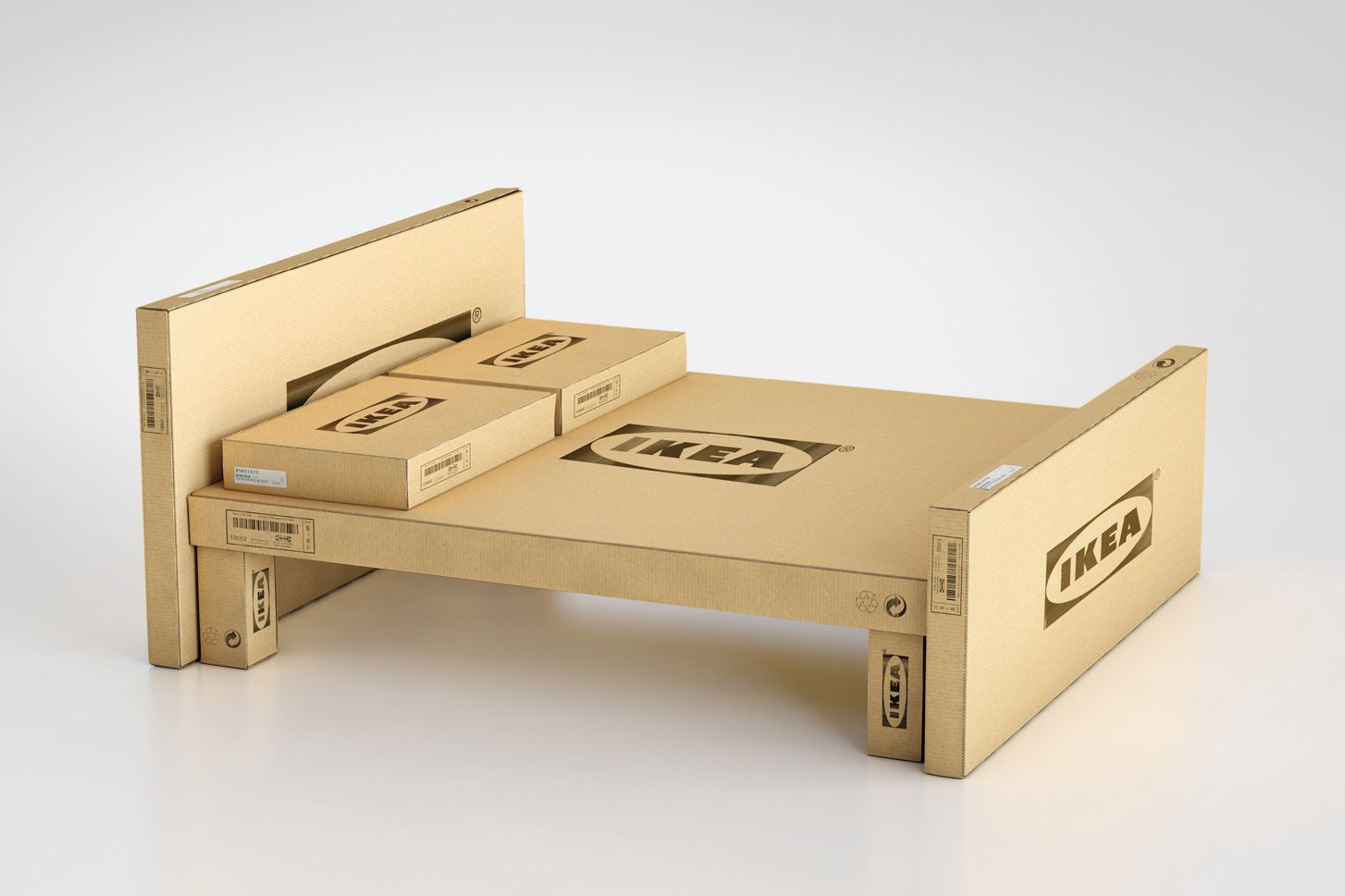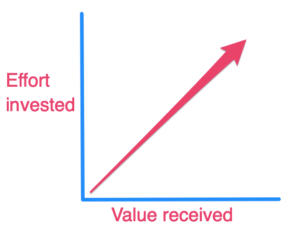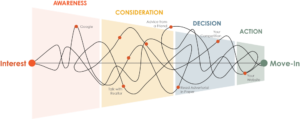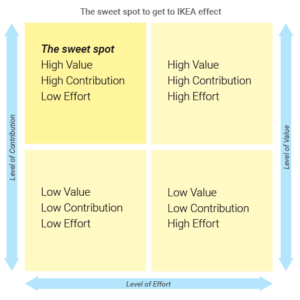
تعريف تاثيرايكيا
تأثير ايكيا هو أن الاشخاص يقدرون المنتجات التي صنعوها بأنفسهم أكثر من المنتجات الجاهزة المماثلة.
The IKEA effect means that people value products they have made themselves more highly than comparable ready-made products.
مصطلح “تأثير ايكيا” ابتكره باحثون أمريكيون مايكل إي. نورتون ودانييل موشون ودان أريلي. في عام 2011 ، أجروا تجربة طلبوا فيها من الناس تجميع صناديق تخزين ايكيا. في النهاية ، سألوا المشاركين عن المبلغ الذي سيدفعونه مقابل الصناديق وقارنوا ذلك بما قالت مجموعة تحكم أنهم سيدفعون مقابل الصناديق الجاهزة. أولئك الذين قاموا بتجميع الصناديق بأنفسهم ذكروا سعرًا أعلى من أولئك في المجموعة الضابطة. كان للعمل الذي استثمروه في تجميع الصناديق تأثير إيجابي على تقديرهم للمنتج.
ثم كرر الباحثون التجربة مع أشياء أخرى ، مثل الأشكال الورقية ومجموعات البناء البسيطة. أعطت كل تجربة نفس النتائج. في دراسة الأوريجامي ، قام الأشخاص الذين صنعوا الأرقام بتسعير إبداعاتهم بخمس مرات أعلى من مجموعة المقارنة.

The term “IKEA effect” was coined by US researchers Michael I. Norton, Daniel Mochon, and Dan Ariely. In 2011, they carried out an experiment in which they asked people to assemble IKEA storage boxes. At the end, they asked the participants how much they would pay for the boxes and compared this to what a control group said they would pay for the finished boxes. Those who had assembled the boxes themselves named a higher price than those in the control group. The work they had invested in assembling the boxes had a positive effect on their appreciation of the product.
The researchers then repeated the experiment with other objects, such as origami figures and simple construction kits. Each experiment gave the same results. In the origami study, the people who had made the figures priced their creations five times higher than the comparison group.
ملحوظة
أثبت Norton و Mochon و Ariely أن تأثير ايكيا يتجاوز بكثير تأثير الوقف. بمعنى آخر ، لا تزيد القيمة المتصورة لمجرد أن الشخص يمتلك المنتج. بدلاً من ذلك ، فإن عملية التجميع نفسها هي التي تؤدي إلى تقدير أعلى للمنتج.
Note
Norton, Mochon, and Ariely proved that the IKEA effect goes far beyond the Endowment Effect. In other words, the perceived value does not increase simply because the person owns the product. Rather, it is the assembly process itself that leads to a higher appreciation of a product.
ما الذي يسبب تأثير ايكيا؟
أشار نورتون وزملاؤه إلى أن جانب “اصنع بنفسك” في هذه المنتجات يتحدث عن حاجة الإنسان العميقة الجذور إلى الكفاءة الذاتية. وفقًا لهم ، يستمد الناس الرضا من الشعور بأنهم قادرون على التأثير على محيطهم ، على سبيل المثال ، من خلال إنشاء الأشياء. وقد ثبت ذلك في دراسات أخرى ، على سبيل المثال ، تلك التي أجراها راسل بيلك (1988) وليتا فوربي (1991) وهيلجا ديتمار (1992).
What causes the IKEA effect?
Norton and his colleagues pointed out that the DIY aspect of these products speaks to the deeply rooted human need for self-efficacy. According to them, people derive satisfaction from the feeling that they are able to influence their surroundings, for example, by creating objects. This was proven in other studies, for example, those by Russel Belk (1988), Lita Furby (1991), and Helga Dittmar (1992).
حقيقة
يحدث تأثير IKEA فقط إذا تم تجميع الكائن بنجاح. وفقًا لـ Norton et al. ، إذا فشل الأشخاص في إنشاء منتج باستخدام الإرشادات المقدمة ، فلن تزداد القيمة التي ينسبونها إليه.
The IKEA effect only occurs if the object is assembled successfully. According to Norton et al., if people fail to build a product using the instructions provided, the value they attribute to it does not increase.
يركز باحثون آخرون على مشاعر الكفاءة ، مدعين أنه عندما يتقن الناس التحدي بنجاح ويمكنهم رؤية النتائج بأعينهم ، فإنهم يدركون قيمة أكبر في المنتج النهائي. لا يزال آخرون يقولون أن التأثير يمكن تفسيره من خلال تأثير عملية الخلق على مفهوم الفرد نفسه.
Other researchers focus on feelings of competence, claiming that when people successfully master a challenge and can see the results with their own eyes, they perceive more value in the finished product. Still others say that the effect can be explained by the influence that the creation processhas on an individual’sself-concept.
تحديات التسويق
تواجه الشركات التي ترغب في تطبيق تأثير ايكيا بأنفسهم تحديًا: كيف يمكنهم إقناع العملاء بالذهاب إلى إصدار DIY من أحد المنتجات؟ ترى ، ما تغفله العديد من الشركات ، هو أن التأثير لا ينطبق إلا بعد الشراء.
يميل الناس مسبقًا إلى بناء قرارهم على عامل الوقت. على سبيل المثال ، في دراسة أخرى أجراها Norton et al. ، قال 92٪ من المشاركين إنهم سيدفعون أكثر مقابل المنتجات الجاهزة مقارنة بمنتجات DIY. كانوا على استعداد فقط لدفع أسعار مميزة لإصدارات DIY بعد تجميعها.
إذن ما هي الاستراتيجيات التي يمكن للشركات اعتمادها لجذب العملاء إلى منتجات “اصنعها بنفسك”؟ حتى الآن ، أثبتت طريقتان نجاحهما: التركيز على سرعة التسليم وتقديم خيارات التخصيص.
فكرة مبتكرة للمتداولين الثابتين – امنح عملائك المحتملين قهوة مجانية! وجد Gibbs و Drolet أنه عندما يكون لدى المستهلكين مستوى طاقة أعلى ، فمن المرجح أن يختاروا التجارب التي تتطلب المزيد من الجهد ، مثل مشاهدة الأفلام الأجنبية مع الترجمة بدلاً من الأفلام بلغتهم الخاصة.
ومع ذلك ، يجب على الشركات دائمًا التأكد من أن جانب “الأعمال اليدوية” لا يمثل تحديًا كبيرًا ، بحيث يمكن إدارته من قبل جميع العملاء المحتملين. إذا فشلوا في القيام بذلك ، فإن خطتهم سوف تأتي بنتائج عكسية ، وسيصاب العملاء بالإحباط والغضب.
Challenges for marketing
Companies wanting to apply the IKEA effect for themselves are faced with a challenge: how can they convince customers to go for a DIY version of a product? You see, what many companies overlook, is that the effect only applies after purchase.
Beforehand, people tend to base their decision on the time factor. For example, in another study by Norton et al., 92% of participants said they would pay more for ready-built products than for DIY products. They were only willing to pay premium prices for the DIY versions after assembling them.
So what strategies can companies adopt to attract customers to DIY products? To date, two methods have proven to be successful: focusing on faster delivery, and offering customization options.
An innovative idea for stationary traders – give your potential customers a free coffee! Gibbs and Drolet found that when consumers have a higher energy level, they are more likely to choose experiences that require more effort, such as watching foreign movies with subtitles instead of movies in their own language.
However, companies must always make sure that the DIY aspect is not too challenging, so that it can be managed by all potential customers. If they fail to do this, their plan will backfire, and customers will be frustrated and angry.
أمثلة على تأثير ايكيا في التسويق
على الرغم من تسمية التأثير لأول مرة في عام 2011 ، إلا أن الكثير من المسوقين كانوا يستخدمونه لعدة عقود قبل ذلك.
في الخمسينيات من القرن الماضي ، قدمت إحدى الشركات المصنعة الأمريكية أول خلطات للخبز في السوق. على الرغم من أن المنتجات تقصر بشكل كبير من عملية الخبز ، إلا أنها لم تنجح في البداية. فقط عندما غيرت الشركة الوصفة بحيث كان على العملاء إضافة بيضة في المنزل ، بدأت شعبية الخلطات حقًا. بالطبع ، كان من المحتمل أن تعمل عدة عوامل مختلفة هنا ، لكن الشعور ببذل بعض الجهد ساهم بلا شك في نجاح المنتج.
منذ ذلك الحين ، تغيرت العلاقة بين الشركات والعملاء. بدلاً من أن يكونوا مستهلكين سلبيين ، يُنظر إلى العملاء بشكل متزايد على أنهم مطورون مشاركون للمنتج. في كل مكان تبحث فيه ، سواء عبر الإنترنت أو في المتاجر ، ستجد الشركات التي وجدت طرقًا إبداعية لإشراك عملائها في عملية تصميم المنتج من أجل الاستفادة من تأثير ايكيا.
أحذية رياضية: يمكن للعملاء اختيار الألوان لتخصيص أحذيتهم عبر الإنترنت.
مصنعي الشوكولاتة: يمكن للعملاء طلب إبداعاتهم الخاصة.
دمى الدببة: يمكن للأطفال تصميم لعبتهم المحببة.
الإجازات: يتقاضى منظمو “إجازات المزرعة العاملة” أسعارًا متميزة على الضيوف للمساعدة في الحظيرة والحقول.
على الرغم من أن هذه الأمثلة تتضمن في المقام الأول التخصيص ، بدلاً من مطالبة العميل بتجميع منتج وفقًا لمجموعة من الإرشادات ، فإن تأثير ايكيا هو الذي يلعب دوره في النهاية ويؤثر بشكل إيجابي على علاقة العميل بالعلامة التجارية والمنتج.
Examples of the IKEA effect in marketing
Although the effect was first named in 2011, lots of marketers had been using it for many decades prior to that.
In the 1950s, a US manufacturer introduced the first baking mixes onto the market. Although the products drastically shortened the baking process, they were not successful at first. It was only when the company changed the recipe so that customers had to add an egg at home that the popularity of the mixes really took off. Of course, several different factors were likely at work here, but the feeling of having put some effort in undoubtedly contributed to the product’s success.
Since then, the relationship between companies and customers has changed. Instead of being passive consumers, customers are increasingly seen as co-developers of a product. Everywhere you look, whether online or in stores, you’ll find companies that have found creative ways of involving their customers in the product design process in order to take advantage of the IKEA effect.
- Sneakers: Customers can choose colors to customize their own shoes online.
- Chocolate manufacturers: Customers can order their own creations.
- Teddy bears: Children can design their own cuddly toy.
- Holidays: Organizers of “Working Farm Holidays” charge premium prices for guests to help out in the barn and fields.
Although these examples primarily involve customization, rather than requiring the customer to assemble a product according to a set of instructions, it’s ultimately the IKEA effect that comes into play and positively influences the customer’s relationship with the brand and product.

رحلة المشتري. يعرف كل مندوب مبيعات في المؤسسة أن رحلة المشتري النموذجي للمستهلكين B2C لا تنطبق على عالم B2B. لا يحدث المثال المتعب لشراء البقالة أو اختيار مطعم عندما يتخذ العملاء قرارات نيابة عن شركتهم ومئات الآلاف (أو حتى ملايين) من الدولارات على الطاولة. رحلة شراء B2B معقدة وغير متوقعة ومتغيرة دائمًا.
The buyer’s journey. Every enterprise salesperson business knows that the typical B2C buyer’s journey just doesn’t apply to the B2B world. The tired example of buying groceries or choosing a restaurant just doesn’t happen when clients are making decisions on behalf of their company and hundreds of thousands (or even millions) of dollars are on the table. The B2B buying journey is complicated, unpredictable and always changing.
To hit the sweet spot we need to aim at creating a product where the level of effort is low but the perceived contribution is high. This way the IKEA effect can be achieved.

Whenever possible let users have control over customization of the product and service.
Design it to be easy to execute (as breaking an egg) and to have a high perceived contribution (as cooking a whole cake).
When you let the users feel in control and put a bit of effort into getting what they need from your product/service, they will form a stronger bond with the product/service.
Digital designers for example can use sample data and editable templates to achieve the IKEA effect. Make the first experience with your app feel dynamic and alive to the users. Prompt them to edit the templates and interact with the product.
Source: ionos
Leave a Reply